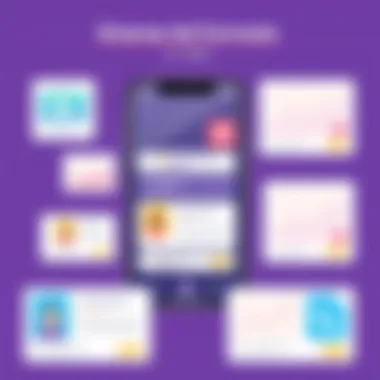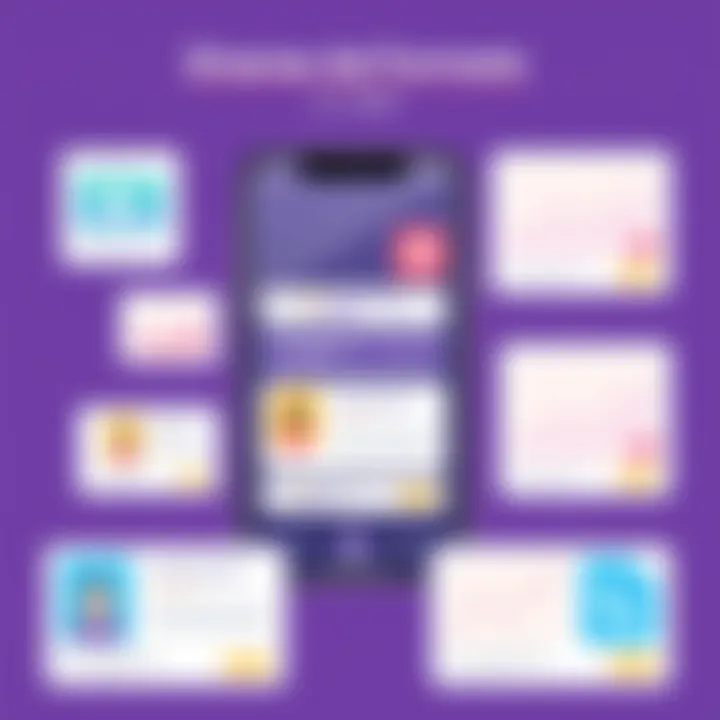Mastering Viber Advertising for Effective Engagement


Intro
In the fast-paced realm of digital marketing, Viber has emerged as a compelling platform for brands keen to carve out their niche in customer engagement. With its unique attributes like end-to-end encryption, group chats, and rich media sharing, Viber offers a dynamic space for businesses to connect with customers. As messaging apps evolve, they increasingly double as marketing channels, making it essential for decision-makers to consider how Viber advertising can enhance their outreach.
Understanding the landscape of Viber advertising is not just about knowing how to post an ad. It includes grasping the subtleties of user interaction, integrating existing marketing strategies, and anticipating future trends. Brands ignoring this growing trend risk missing out on a large chunk of potential customers.
This article unfolds various strategies pertinent to Viber advertising, guiding readers through effective engagement techniques. By analyzing real-world examples and best practices, businesses can acquire solid tactics that amplify their visibility and foster lasting connections with their audiences.
Industry Overview
Current Trends in Viber Advertising
The advertising ecosystem on Viber is continuously shifting, with more brands recognizing the influence of direct messaging on consumer decisions. Recent trends show that interactive content, such as polls and surveys via Viber chats, is gaining traction. This demystifies the process for consumers, allowing them to engage at their pace, thus enhancing trust and brand loyalty.
Moreover, businesses are increasingly utilizing chatbots, which facilitate personalized customer interactions without human oversight. These bots not only push promotions but also handle customer inquiries swiftly, making the experience seamless.
Key Challenges Faced by Businesses
Despite the potential, navigating Viber advertising isn't without hurdles. One significant challenge is the oversaturation of promotional messages. Consumers often find their chats cluttered, which can lead to disengagement. Cutting through this noise requires innovative approaches and creative content that captivates attention immediately.
Additionally, businesses must contend with varying regional regulations regarding customer data privacy. Ensuring compliance can complicate campaign strategies, necessitating a thorough understanding of local laws and Viber's policies.
Emerging Technologies Impacting Viber Advertising
As technology innovations continue, artificial intelligence stands out as a game changer in Viber advertising. AI tools can analyze customer data efficiently, tailoring advertisements to individual user preferences. This not only drives higher engagement rates but can also increase conversion rates significantly.
The rising popularity of augmented reality (AR) experiences in messaging apps cannot be overlooked. Some brands experiment with AR-based ads allowing users to interact with products virtually. This could pave the way for immersive advertising on Viber.
Viber Advertising Formats
Businesses can deploy various formats within Viber to better engage their audience. These might include:
- Sponsored Stickers: Creative and fun, these allow businesses to embed their brand within users’ daily chats.
- In-Chat Ads: Placed directly in chats, these ads capture attention without disturbing user flow.
- Viber Communities: Establishing a community can help businesses create a loyal customer base, centering conversations around their brand.
Being strategic in the selection of formats can significantly enhance advertising outcomes.
Implementation Strategies
Best Practices for Effective Advertising on Viber
To hit the ground running, businesses should consider the following best practices:
- Audience Research: Understanding the preferences and behaviors of the target audience is crucial for meaningful engagement.
- Content Quality: High-quality visuals and concise messages resonate better with users, making them more likely to interact.
- A/B Testing: Experimenting with different formats and messages allows businesses to identify what works best.
Integration with Existing Marketing Frameworks
It's essential to ensure that Viber strategies align with overarching marketing goals. Integrating Viber with other social media platforms can create a unified brand narrative, making the message seamless across channels.
Resources for Training and Support
Brands entering this advertising field should leverage available training resources. Many online platforms offer tutorials on crafting effective campaigns on messaging apps, equipping teams with essential skills. Furthermore, Viber's support channels can provide insight into utilizing features effectively, ensuring a smoother transition.
Future Trends in Viber Advertising
Predictions for the Future
The changes in Viber advertising are bound to accelerate in the coming years. As users become accustomed to interactive experiences, brands will need to continually innovate. Expect to see a rise in personalized campaigns, where data leads to tailored messages that are more likely to resonate with individual users.
Upcoming Technologies
Anticipate growth in voice-activated advertising. With smart speakers and voice recognition gaining momentum, creating campaigns that leverage voice interactions could soon be a necessity for brands seeking to stay ahead.
Recommendations for Future-Proofing
To ensure long-term viability in Viber advertising, brands should cultivate adaptability. Keeping an eye on emerging trends, experimenting with avant-garde technologies, and fostering a culture of creative thinking within marketing teams can safeguard against obsolescence.
The blend of traditional marketing fields and the rising influence of messaging apps like Viber showcases just how nuanced the modern advertising landscape has become. Armed with insights and strategies, businesses can hope to navigate these waters with increasing confidence.
Understanding Viber Advertising


In today's fast-paced digital landscape, grasping the nuances of Viber advertising holds significant value. It goes beyond just mere promotions; it taps into the pulse of communication that resonates with users. As a business seeking to connect with customers on a deeper level, honing in on how Viber operates opens new avenues for engagement and brand presence. This section aims to elucidate the intricate anatomy of Viber advertising and its essential benefits.
The Evolution of Messaging Apps
Messaging apps have transformed dramatically since the inception of simple text messages. In the early days, they were primarily about sending bare-bones texts—like sending smoke signals, just more modern. Fast forward to today, and platforms like Viber have evolved into comprehensive communication ecosystems. Viber was among the pioneers in offering features like voice and video calls, stickers, and group chats. This evolution underpins its purpose—to not solely be a messaging tool but a medium for brands to interact engagingly with users.
With more than 1 billion registered users globally, the power of messaging apps as marketing channels can’t be understated. Brands that recognize this evolution can tailor their strategies effectively, catering to an audience that now expects more interactive, visually rich content. The shift from traditional advertising to this focused communication highlights how Viber fits into the broader marketing ecosystem.
Viber's Unique Position in the Market
Viber finds itself in a unique niche among messaging apps. With its robust feature set, it combines the benefits of social media platforms with the intimacy of personal messaging. Unlike more widely recognized counterparts like WhatsApp or Facebook Messenger, Viber appeals to users looking for a blend of privacy and community.
Viber's standout factor is its rich integration of advertising options, which allows brands to bridge the gap between user convenience and engagement. Brands can create a sense of community rather than merely broadcasting their messages. Moreover, features like Viber Communities enable brands to build dedicated spaces for their customers, fostering an ongoing dialog. This is not just advertising; it’s building relationships and creating lasting impressions. This positioning allows companies to harness the power of personalization, which is a crucial aspect of today’s marketing strategies.
Furthermore, Viber has tapped into local cultures in many countries, customizing its approach to fit regional expectations. This localization ensures that advertising feels relevant and relatable, adding a layer of authenticity that many users appreciate. When businesses understand and accept why Viber is distinct in its market positioning, they can deploy their campaigns more effectively, allowing for a greater return on investment than traditional media might offer.
"Understanding the positioning of Viber in the messaging landscape is pivotal for brands seeking to create meaningful connections with their audiences."
With engagement strategies steeped in cultural relevance and community focus, Viber advertising emerges as a compelling option for brands ready to shift gears in their marketing efforts. As we continue exploring the key features and types of advertising on Viber, businesses will find that this platform has much to offer in the quest for impactful engagement.
Key Features of Viber Advertising
In the bustling world of digital marketing, Viber stands out as a powerful platform that brands are increasingly turning to. Knowing the key features of Viber advertising is essencial for businesses aiming to tap into this dynamic channel. Viber offers tools that allow for richer, more targeted engagement compared to other messaging platforms. Marketers can create ads that resonate deeply with audiences, fostering connections that can lead to higher conversion rates.
Rich Media Messaging
Viber's capabilities in rich media messaging provide brands with unique avenues to tell their stories. Unlike simple text messages, rich media includes images, videos, and interactive elements that are more engaging for users. This transforms ordinary communications into captivating experiences.
For instance, a local restaurant might send a mouth-watering video of a chef preparing a signature dish, or a fashion retailer could share vibrant images of their latest collection. This dynamic approach elicits emotional responses, making users more likely to engage with the content.
Furthermore, rich media messaging not only aids in grabbing attention but also contributes to message retention. Content that incorporates visuals is often remembered better than text alone. To maximize the impact, it’s important for advertisers to ensure that the media aligns well with their brand identity and the message they want to convey.
Targeted Advertising Options
One of the standout features of Viber advertising is its targeted advertising options. The platform allows businesses to reach specific demographics based on various factors such as location, interests, and behaviors. This ability to laser-focus on target audiences is a game changer, especially for brands looking to maximize their advertising budgets.
With targeted ads, a travel agency could showcase holiday packages specifically to users who have shown interest in travel-related content. This not only enhances the chances of conversion but also reduces wasted ad spend on irrelevant audiences.
More importantly, being able to target effectively means that businesses can craft messages that resonate with their selected audience segments. The right message, delivered to the right audience, elevates the likelihood of interaction and subsequent customer loyalty. Keeping profiles up to date is vital in ensuring effectiveness in this targeted approach.
Integration with Chatbots
Integrating with chatbots on Viber represents another innovative feature that positions businesses to provide enhanced customer service. Businesses can create automated responses that allow customers to get quick answers without the need for human intervention. This is vital in today’s fast-paced environment where customer expectations for instant support continue to rise.
When a customer reaches out about a product, a chatbot can provide instant information, guide them through the purchase process, or even assist in booking appointments—all within the Viber environment. This seamless interaction improves user experience and maintains engagement with the brand.
Additionally, chatbots can gather valuable insights on customer preferences and frequently asked questions. This information can inform future marketing efforts, allowing businesses to tailor their content even further to meet consumer demand.
In summary, the key features of Viber advertising enrich the interactions between brands and their audiences. Understanding how to utilize rich media, leverage targeted options, and integrate chatbots can significantly enhance engagement strategies. As Viber continues to evolve, these features will likely play an increasingly central role in effective advertising campaigns.
Types of Advertising on Viber
Understanding the different types of advertising available on Viber is crucial for businesses seeking to maximize their outreach and marketing effectiveness. Viber provides a unique landscape for brands to connect with users through various formats, each offering its own set of advantages and challenges. By leveraging these types, marketers can ensure that their messaging resonates and engages their target audience effectively.
Sponsored Messages
Sponsored messages on Viber represent a direct line of communication between brands and users. They function similarly to traditional advertising but in a context where users are already engaged. This can lead to significantly higher engagement rates since users are more likely to open messages from a platform they regularly use. Here are some points to consider with sponsored messages:
- Direct Engagement: Unlike banner ads, sponsored messages appear in users’ chats, making them less likely to be ignored. They are perceived as more personal.
- Customization: Businesses can tailor these messages to different audience segments, enhancing the relevance of the content shared.
- Call to Action: Including a direct call to action can lead to immediate responses, whether it’s visiting a website or completing a purchase.
However, inserting promotional content in a user’s chat must be handled delicately. If done too frequently or without relevance, it can lead to user frustration.
Viber Communities and Their Role
Viber communities are a blend of group chats designed for users with common interests, providing brands with an opportunity to engage a targeted audience. This format enables businesses to participate in conversations that matter to their consumers, fostering a sense of community.
- Building Relationships: By participating in these communities, brands can foster relationships with users, answering queries and providing valuable content.
- Content Sharing: Communities are a great place for brands to share rich media, such as videos or infographics, that resonate more with users than plain text.
- Feedback Mechanism: Brands can gain insights into customer preferences and pain points through real-time feedback offered in discussions.
It's essential for brands to focus on providing value rather than overt promotions within these spaces. Over-enthusiasm for advertising could backfire and diminish the community's trust.
Public Accounts for Brands


Establishing a Public Account on Viber offers businesses a platform to promote their brand in a structured manner. This gives companies a consistent voice and presence on the platform. Public accounts allow brands to:
- Share Updates: Regularly keep users informed about new products, services, or promotions.
- Engage Content: These accounts can post updates much like a social media feed, encouraging users to interact with content regularly.
- Analytics Access: Businesses gain access to analytics that help them understand engagement trends and optimize their communication strategies based on user interaction.
However, maintaining engagement is key; brands must ensure that the content is helpful and relevant to their audience's interests. Without consistent value delivery, public accounts may fall flat, leaving users disinterested.
Leveraging diverse advertising types on Viber not only enhances brand visibility but also fosters meaningful interactions with customers. Each format serves as a cog in the larger marketing machine, pushing brands toward well-rounded engagement strategies.
In summary, these diverse advertising avenues within Viber present distinct pathways for brands to cultivate relationships with users. The success of any campaign will heavily depend on how well businesses navigate and employ each advertising type, focusing on thoughtful interaction rather than solely promotional messaging.
Advantages of Viber Advertising
In the competitive landscape of digital marketing, Viber advertising emerges as a notable option for business looking to enhance their customer engagement. With a user base that stretches across different demographics and markets, leveraging Viber's unique features can offer substantial advantages. Businesses must consider how this platform can effectively serve their needs while providing meaningful connections to their audiences.
Increased Engagement Rates
One standout benefit of Viber advertising is its impressive engagement rates. Consumers engaged on messaging platforms like Viber tend to interact with content much more readily compared to traditional social media channels. The platform is designed for personal conversations, making interactions feel more intimate and less orchestrated. This personal touch leads to higher open rates for messages, resulting in more users actually reading and responding to ads.
"With Viber, businesses can tap into the chat culture, where messages feel less like advertisements and more like conversations. This is a game-changer for engagement."
For example, a retail brand can send personalized offers directly through Viber messages, prompting users to take action immediately, something that's often lost in email marketing campaigns.
Cost-Effectiveness Compared to Other Platforms
Another noteworthy advantage of Viber advertising is its cost-effectiveness relative to other digital marketing channels. While some widely-used platforms like Facebook and Instagram require substantial budgets for effective reach, Viber offers more accessible advertising options, allowing small and medium-sized enterprises to engage in advertising without breaking the bank. This allows businesses to allocate their marketing budgets in a more versatile way, enabling them to experiment with various ad formats and see what resonates best with their audience.
Additionally, since businesses can directly communicate with users, the cost associated with potential conversion might be lower. Brands find themselves achieving similar, if not better results, with lower investment—leading to improved ROI.
Enhanced Customer Interactivity
Viber encourages a higher degree of interactivity between brands and consumers, setting it apart from many other advertising platforms. With built-in features such as polls, quizzes, and one-on-one chat capabilities, brands can solicit direct feedback from users. This fosters a sense of community and collaboration, allowing customers to feel heard and valued. By integrating these features into their marketing strategies, companies can gather significant data on customer preferences and pain points, further refining their offerings.
Moreover, coupled with the option to integrate chatbots, businesses can provide instant responses to queries, enriching the user's experience. With real-time communication, not only does this enhance satisfaction, but it also improves the brand image, as customers appreciate responsive support during their engagement.
Challenges in Viber Advertising
As businesses increasingly lean on Viber as a marketing tool, understanding the obstacles they may encounter is essential. The complexities of Viber advertising challenge advertisers to rethink strategies, ensuring their efforts remain fruitful amidst a landscape of user expectations and technological constraints. Identifying key challenges allows businesses to not only navigate difficulties but. also to seize opportunities where competitors might falter. This section will explore user privacy concerns and algorithm limitations, shedding light on the intricacies of advertising through Viber and equipping brands with the knowledge to effectively address these challenges.
User Privacy Concerns
Today’s digital environment places a spotlight on user privacy, especially with regulations like the General Data Protection Regulation (GDPR) in Europe and various privacy laws in other parts of the world. Viber users expect a high degree of confidentiality. Any perceived intrusiveness by brands can result in backlash or even potential loss of trust. This concern impacts how advertisers craft their campaigns.
Advertisers must find the right balance between effective marketing and respecting user privacy. Here are some key points to consider:
- Transparent Communication: Clearly articulate how user data is collected and used. Providing users with an easy-to-understand privacy policy can foster trust.
- Consent Management: Always seek explicit approval from users before sending promotional messages. This respects their autonomy and builds trust.
- Opt-Out Options: Make it easy for users to opt out of advertising messages. A straightforward process can help mitigate frustrations and enhance user satisfaction.
"Privacy is not an option, and it shouldn’t be the price we accept for just getting on the Internet.” - Gary S. Kessler
This adage resonates deeply in the context of advertising on Viber, underscoring the absolute necessity to prioritize user privacy.
Algorithm Limitations
Another layer of complexity in Viber advertising arises from the platform’s algorithms. These algorithms determine the visibility and engagement of advertisements, impacting their reach and effectiveness. Advertisers who fail to adapt can find their campaigns underperforming or even being misaligned with target audiences.
Here are a few algorithm-related factors to be mindful of:
- Tiered Distribution: Not all messages reach the same number of users. Viber employs a tiered distribution system that favors well-performing content. Therefore, advertisers should prioritize creating focus on high-quality, engaging messages.
- Content Relevancy: Posting frequent content that resonates with target audiences is crucial. If the algorithm deems the content irrelevant or unengaging, brands may find their messaging is buried. This calls for constant analysis of audience feedback to refine content strategies.
- Market Saturation: With rising adoption of Viber as a marketing channel, the competition is getting stiffer. Advertisers need to remain innovative to cope with algorithm changes that prioritize user experience over ad exposure.
By addressing user privacy concerns and understanding algorithm limitations, brands can enhance their Viber advertising strategies. Armed with insight into these challenges, businesses not only demonstrate professionalism but also gear themselves for sustainable success in their advertising efforts.
Best Practices for Viber Advertising
In the fast-paced world of digital marketing, leveraging Viber's unique functionalities can make a noticeable difference in a brand's advertising outcomes. The best practices for Viber advertising provide a roadmap for businesses aiming to maximize their impact. When executed effectively, these strategies can lead to stronger customer connections, heightened engagement, and ultimately, improved conversion rates. Understanding what works best on this platform is crucial for marketers and decision-makers alike.
Crafting Compelling Messages
Creating messages that resonate with your audience is no walk in the park, especially in the cluttered digital space where attention spans are thinner than a dime. So, it’s vital to grab readers’ attention straight out of the gate.
- Be Concise: Keep messages short and to the point. Viber users often skim content, so a crisp message can lead to higher engagement. Consider this: if your message is as long as a Tolstoy novel, it might not get read at all.
- Use Visuals: Incorporate images and videos where possible to boost engagement. A striking image can convey a whole story that text sometimes struggles to express. Remember, a picture is worth a thousand words, especially in Viber’s rich media architecture.
- Incorporate a Call-to-Action: Always guide your audience on what to do next—whether it’s clicking a link or replying with a keyword for more info. Your goal is to create a sense of urgency or interest that nudges users towards interaction.
Utilizing Analytics for Optimization


Now, here’s a nugget of wisdom: if you’re not looking at the numbers, you're basically flying blind. Analyzing performance data on Viber can provide the insights necessary to define future successes. Here are important areas to focus on:
- Engagement Rates: Track how users interact with your messages. Are they clicking, ignoring, or unsubscribing?
- Conversion Tracking: Understand which messages drive actual sales or desired actions. Identifying patterns allows for refining your strategy.
- Demographic Insights: Use data to pinpoint who your audience is, where they’re located, and what they are interested in. This knowledge helps tailor your messaging to be more relevant.
Testing Different Formats
Variety is the spice of life, and the same goes for advertising on Viber. Testing various formats ensures you don’t put all your eggs in one basket. Consider experimenting with:
- Sponsored Messages: They can help reach a broader audience. Test different creatives and copy to see what sticks.
- Polls and Surveys: Engaging users through questions gives them a voice while providing valuable feedback to you. It’s all about creating a conversation.
- Rich Media Content: From animated GIFs to short videos, these formats often yield better interaction rates. Users tend to engage deeper with entertaining visuals.
Utilizing these best practices can streamline your Viber advertising efforts. Every piece you send should be crafted purposefully, analyzed thoroughly, and tested robustly. As the landscape shifts, staying nimble and responsive to new trends and data is what will ultimately set you apart in this digital communication game.
Case Studies in Viber Advertising
In the realm of Viber advertising, case studies serve as illuminating beacons, showcasing real-life applications and outcomes of various marketing strategies. Analyzing these examples not only highlights the potential for successful campaigns but also exposes pitfalls to avoid. By looking at the experiences of others, brands can glean insights into effective tactics and innovative approaches that can engage audiences meaningfully.
Success Stories from Top Brands
One of the most compelling aspects of Viber advertising is its ability to foster genuine engagement. Successful campaigns tend to center around creativity and relevance. For instance, Coca-Cola utilized Viber’s rich media features to launch an interactive campaign during a major sporting event. By sending branded stickers and GIFs to users, they increased interaction rates dramatically. This campaign’s success can largely be attributed to its alignment with audience interests and the emotional connection that the brand fostered through fun, shareable content.
As another example, Samsung employed targeted messages to promote the launch of a new smartphone model. By leveraging Viber’s segmentation capabilities, they were able to reach tech-savvy users with personalized offers, which resulted in higher conversion rates than traditional advertising channels. With data indicating that targeted messages can generate engagement levels up to 50% higher, Samsung's approach exemplifies effective use of data in Viber advertising.
To summarize, successful brands on Viber share a few essential traits: they create relevant content, leverage user engagement features, and tailor their messaging to specific audience segments. Each of these campaigns serves as a testament to the platform's unique capabilities in crafting impactful marketing efforts.
Lessons Learned from Failed Campaigns
While success stories are uplifting, the lessons drawn from failed campaigns are equally valuable. For example, an online retail company that ventured into Viber advertising launched a campaign that relied heavily on automated messages without adequate personalization. The results were disappointing; users found the messages intrusive and irrelevant. The brand's lack of understanding of their audience led to low engagement and ultimately, negative feedback.
Another instance involved a small business that attempted to run a promotional campaign on Viber without considering the time zone differences of their target audience. Sending messages during off-hours led to a significant drop in interaction, which demonstrates how crucial timing and audience knowledge are in crafting campaigns that resonate effectively.
"Understanding your audience is the bedrock of any successful advertising strategy. Ignoring this can lead to missteps that are costly and damaging."
The perils witnessed in these failed attempts underline the need for thoughtful planning and execution. Brands should take heed of these examples, thoroughly researching their audience, and considering full marketing strategies that leverage the unique tools Viber offers.
Future Trends in Viber Advertising
The landscape of digital advertising is ever-changing, and Viber advertising is no exception. It’s critical for brands utilizing this platform to keep their fingers on the pulse of emerging trends. This foresight not only aids in enhancing engagement but also ensures that strategies stay relevant in an increasingly competitive marketplace. Understanding where Viber advertising is headed can offer businesses valuable insights into how they can optimize their efforts for better results and a higher return on investment.
Emerging Technologies and Their Impacts
As technology weaves itself deeper into the fabric of our daily interactions, its influence on advertising strategies grows. Viber is no different; the adoption of new technologies is paving the way for smarter, more efficient advertising practices. Here’s what to keep an eye on:
- Augmented Reality (AR) Integration: Brands are beginning to experiment with AR, allowing users to interact with products in a more immersive manner. Picture a shoe store where potential buyers can see how shoes look on them without ever leaving home. These kinds of innovations make the advertising more engaging and can boost conversion rates significantly.
- Artificial Intelligence (AI) Chatbots: These bots are becoming more sophisticated, enabling brands to provide instant support to Viber users. Imagine a scenario where a consumer asks a question about a product, and the AI delivers personalized recommendations in real-time. This kind of immediate interaction enhances customer experience and can lead to heightened loyalty.
- Data Analytics Tools: The advancement of analytics tools is allowing businesses to segment audiences more effectively. For instance, if a restaurant promotes a new dessert, it can analyze feedback in real-time and adjust its strategies swiftly. Utilizing these advanced tools can lead to more tailored advertising efforts that resonate more strongly with target demographics.
"In the world of Viber advertising, staying ahead means embracing innovation and being ready to pivot with trends."
Predictions for User Engagement
As we look ahead to the future, several trends can be anticipated regarding user engagement on Viber:
- Increased Personalization: Users will expect ads tailored specifically to their preferences. Brands that leverage user data responsibly to create bespoke experiences will enjoy higher engagement rates. Consumers are more likely to respond positively to ads that speak directly to their interests.
- Shorter Content Formats: Attention spans are shrinking, and concise messaging will become even more crucial. Practices such as crafting impactful messages in under 30 seconds or creating snippets for quick sharing could see increased effectiveness. The adage "less is more" will come into play here.
- Emphasis on User-Generated Content (UGC): Companies may prioritize UGC more than ever. Encouraging customers to share their experiences via Viber can lead to organic reach and community building. For example, a clothing brand might ask satisfied customers to share their photos wearing the latest styles, creating a sense of authenticity that resonates well with peers.
In essence, as Viber advertising evolves, understanding these future trends can help brands navigate the digital landscape with confidence. Adapting to new technologies and shifting user expectations can not only fortify engagement but also enhance overall brand loyalty in this dynamic marketplace.
The End
In summary, Viber advertising presents a myriad of opportunities for brands looking to engage effectively with their audience. The platform's unique features, including targeted ad options and rich media messaging, allow companies to tailor their communications to specific demographics, making it a vital channel for modern marketing strategies. As user preferences continue to evolve, embracing innovative formats such as sponsored messages and public accounts can enhance brand visibility and interaction.
It's essential to acknowledge both the advantages and challenges outlined in this article. While Viber boasts high engagement rates, privacy concerns and algorithm limitations could pose obstacles for marketers. Therefore, businesses must prioritize user trust and data protection in their advertising initiatives.
Ultimately, a well-thought-out approach that incorporates the best practices identified, such as compelling messaging and analytics utilization, can lead to impactful engagement. The landscape of Viber advertising is positioned for growth, and brands that adapt their strategies in response to emerging trends and consumer expectations will undoubtedly reap the rewards.
Summation of Key Points
- Viber's unique advertising features lie in its targeted approaches, rich media options, and integration with chatbots, which help brands deliver personalized messages.
- Engagement and cost-effectiveness make Viber stand out among messaging platforms, positioning it as an attractive option for advertisers.
- Challenges like privacy concerns must be approached with serious consideration to maintain user trust while navigating algorithm limitations.
- Best practices such as data-driven optimization and diverse format testing are crucial for successful campaigns on the platform, allowing brands to refine their messaging and enhance audience interactions.
- Future trends point to an increased role for emerging technologies and deeper analysis of user engagement, guiding brands towards the strategies of tomorrow.
Final Thoughts on Viber Advertising
As we look to the future, Viber advertising holds immense potential for brands ready to explore its depths. This dynamic platform serves not just as a marketing tool but as a means to forge genuine connections with audiences. By employing the strategies discussed and being mindful of evolving consumer behavior, businesses can elevate their messaging beyond mere advertisements.
Moreover, as Viber continues to innovate, staying informed of the latest technologies and trends will empower marketers to tap into new opportunities. The secret sauce lies in crafting relatable content that resonates with consumers and drives them to interact.
Adapting to the nuances of Viber as a unique advertising platform can lead brands to not just engage, but to create lasting relationships with their audiences. In a landscape where connections are key, Viber could become the go-to for brands aiming to bridge the gap between them and their customers effectively.
"In the world of advertising, adapting to change is not just a strategy; it's a necessity for survival and growth."
For further exploration of Viber and its advertising tools, consider visiting Wikipedia to understand its evolution and features.



